While the past weekend afforded me another chance to check the progress of the new queen, I thought I would shift gears for this post and talk about some of the equipment that is involved in beekeeping. For someone contemplating the beekeeping hobby, equipment is certainly something that will need some preparation and forethought. As for those of you just interested in how the hobby works, it will help you understand some of the nomenclature as well as offer some insight into why things are done the way they are.
Before jumping in to some of the stuff a beekeeper uses, I have to say that it was a relief getting to actually see the queen as I was looking through the hive – for a while there I though my eyesight wasn’t serving me well. I was also surprised to see that the bees were more active in building burr comb (comb that isn’t supposed to be there – kinda like weeds :-D) and ‘gluing’ everything together with propolis. What a difference a queen can make! My last observation was about the sound – odd as it might seem, it was actually kind of relaxing hearing the low hum of the hive as I was checking things out. For someone who was conditioned by society to fear that noise (cartoons of bees attacking Yogi Bear come to mind :-)) I thought it was kind of neat.
Woodenware
 The components that come together to create the beehive you have seen in earlier posts are sometimes referred to collectively as ‘woodenware’. Together, they make the modern beehive, which is often called a ‘Langstroth’ hive after its inventor. These hives have a number of benefits over their predecessor, the basket or skep hive, but the biggest is that it allows you to inspect your bees (and harvest honey!) without destroying the hard workers and their home. Other benefits of the Langstroth hive are the interchangeability of parts and the ideal amount of ‘bee’ space inside (too much space and the bees will build burr comb, which makes a mess). A breakdown of the major woodenware components are found in the picture on the left. The following subsections will discuss what each of the components shown are used for.
The components that come together to create the beehive you have seen in earlier posts are sometimes referred to collectively as ‘woodenware’. Together, they make the modern beehive, which is often called a ‘Langstroth’ hive after its inventor. These hives have a number of benefits over their predecessor, the basket or skep hive, but the biggest is that it allows you to inspect your bees (and harvest honey!) without destroying the hard workers and their home. Other benefits of the Langstroth hive are the interchangeability of parts and the ideal amount of ‘bee’ space inside (too much space and the bees will build burr comb, which makes a mess). A breakdown of the major woodenware components are found in the picture on the left. The following subsections will discuss what each of the components shown are used for.
Hive Stand & Bottom Board
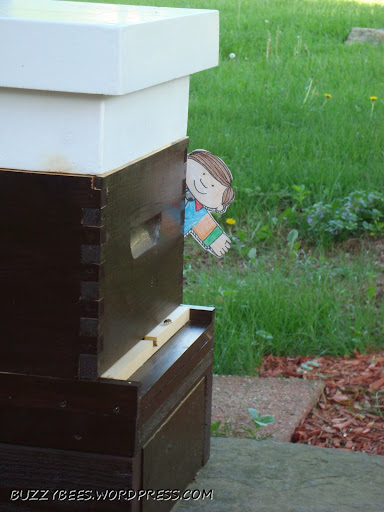 The hive stand’s primary purpose is to elevate the hive up off the ground to keep intruders such as water, other insects, and animals from entering the hive. The one pictured above is a bit more complicated that many stands – some use a level tree stump! If you look at the picture at left from when Flat Stan visited, you can see that my hive is basically sitting on a rectangle made of 2x4s and a stone slab.
The hive stand’s primary purpose is to elevate the hive up off the ground to keep intruders such as water, other insects, and animals from entering the hive. The one pictured above is a bit more complicated that many stands – some use a level tree stump! If you look at the picture at left from when Flat Stan visited, you can see that my hive is basically sitting on a rectangle made of 2x4s and a stone slab.
The next part up from the stand is the bottom board. In the left-hand picture, the bottom board is seen underneath the unpainted board in front of the entrance to the hive. The bottom board lifts up the hive body to create a space so the bees can enter and leave the hive. Additionally, bottom boards such as mine are screened to allow for better ventilation and to catch mite which happen to fall from bees in the hive!
Hive Body, Supers, & Frames
 The brood chamber, (where the bees live, rear their young, and store their own honey) consists of 1 to two ‘deep’ hive bodies. These usually come either 8 or 10 frame configurations, which is simply a measure of how many frames can be placed in the body. The term ‘deep’ indicates that these are the tallest of the three sizes of frames. As you can see in the picture on the left, the frames hang from a groove in the top of the hive body. The picture also shows how the hive looks when you have the two hive bodies together to make the brood chamber.
The brood chamber, (where the bees live, rear their young, and store their own honey) consists of 1 to two ‘deep’ hive bodies. These usually come either 8 or 10 frame configurations, which is simply a measure of how many frames can be placed in the body. The term ‘deep’ indicates that these are the tallest of the three sizes of frames. As you can see in the picture on the left, the frames hang from a groove in the top of the hive body. The picture also shows how the hive looks when you have the two hive bodies together to make the brood chamber.
When you are inspecting a hive, you typically remove one frame from the body you are inspecting to allow more space to work the other frames. In this picture, I was busy checking the upper hive body (which is beginning to have the comb drawn out so the bees can use it to store supplies and brood) so I had my smoker handy and one frame pulled out.
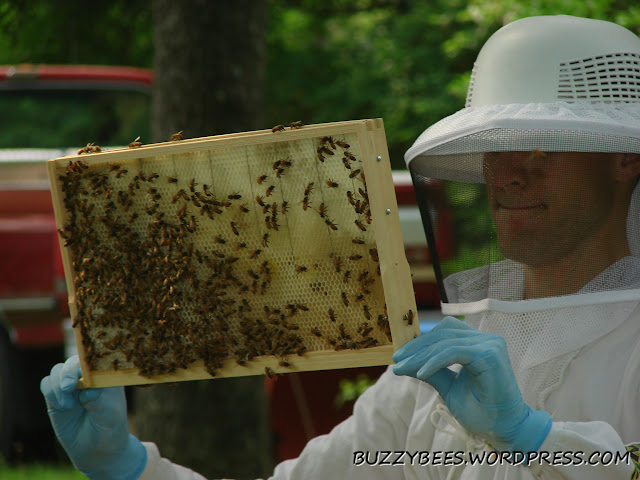 Frame height varies with the hive bodies they go in. For example a deep frame would be used in a deep body. Otherwise, they are essentially similar in all the other dimensions (during re-queening I actually stacked my two supers to create a place to put frames in temporarily).
Frame height varies with the hive bodies they go in. For example a deep frame would be used in a deep body. Otherwise, they are essentially similar in all the other dimensions (during re-queening I actually stacked my two supers to create a place to put frames in temporarily).
Speaking of supers, my hive hasn’t gotten far enough along to start putting more ‘storage’ space in the hive. Stay tuned though, we might be able to get one or two honey supers on later in the season so we can get some honey! 🙂
Inner & Outer Cover
 While the outer cover’s function is pretty obvious (i.e. it keeps stuff out :-D), the inner cover is often a bit more of a mystery. As you can see on the left, the inner cover is essentially a sheet of wood with a hole in the center and a ridge around the perimeter on both sides (although this can vary between inner cover designs). Appreciating that I originally thought that the inner cover was the ‘back door’ to the hive and helped with ventilation, I was confused at the purpose of a cover such as mine (which didn’t have a hole in one of the sides for the bees to leave the hive from). After doing some research, it seems as though the inner cover’s major function is to create an air gap between the hive and the outer cover. While that little pocket of air might not mean much for us during the summer time, it is actually a big help in maintaining the hive’s temperature during the chillier months!
While the outer cover’s function is pretty obvious (i.e. it keeps stuff out :-D), the inner cover is often a bit more of a mystery. As you can see on the left, the inner cover is essentially a sheet of wood with a hole in the center and a ridge around the perimeter on both sides (although this can vary between inner cover designs). Appreciating that I originally thought that the inner cover was the ‘back door’ to the hive and helped with ventilation, I was confused at the purpose of a cover such as mine (which didn’t have a hole in one of the sides for the bees to leave the hive from). After doing some research, it seems as though the inner cover’s major function is to create an air gap between the hive and the outer cover. While that little pocket of air might not mean much for us during the summer time, it is actually a big help in maintaining the hive’s temperature during the chillier months!
 My outer cover is made of a polystyrene material, which makes it lightweight and – apparently – more durable than its counterparts. You will see many outer covers that tout that they are ‘telescoping’. If you are like me, you will think that they somehow expand. However, this appears to be a marketing catch phrase to say that the outer cover is large enough to overhang the entrance to the hive. That might not sound like a big deal, but it is to the bees when it rains!
My outer cover is made of a polystyrene material, which makes it lightweight and – apparently – more durable than its counterparts. You will see many outer covers that tout that they are ‘telescoping’. If you are like me, you will think that they somehow expand. However, this appears to be a marketing catch phrase to say that the outer cover is large enough to overhang the entrance to the hive. That might not sound like a big deal, but it is to the bees when it rains!
Hope this primer is helpful in understanding some of the stuff you see floating around in my pictures and descriptions. In future posts I hope to talk about some of the tools beekeepers use as well as the other parts of the woodenware that we’ll need as the colony expands!
 When I originally buttoned up the hive for winter, I figured that there was a good possibility of a bear paying a visit this spring. However, my novice thinking was that the bear would move on to something easier after not being able to push the hive from between the straps and the stone pad. Apparently, this bear was smarter than the average bear!
When I originally buttoned up the hive for winter, I figured that there was a good possibility of a bear paying a visit this spring. However, my novice thinking was that the bear would move on to something easier after not being able to push the hive from between the straps and the stone pad. Apparently, this bear was smarter than the average bear!







 The beekeeper has a number of tools to help him in his trade, from the protective garments they wear to the hand tools, medicines, and other ‘toys’ that have a part in the care of bees. However, undeniably the beekeepers most important tool is themselves. Aside from the obvious task such as lifting frames with their hands, the beekeeper must also use all of their senses during inspections to help in gauging the health of the hive. Perhaps even more important is the tool underneath the net hood! The learned beekeeper is their best tool since an understanding of how the hive functions and possible pitfalls go far in being proactive in addressing small problems before they become big problems.
The beekeeper has a number of tools to help him in his trade, from the protective garments they wear to the hand tools, medicines, and other ‘toys’ that have a part in the care of bees. However, undeniably the beekeepers most important tool is themselves. Aside from the obvious task such as lifting frames with their hands, the beekeeper must also use all of their senses during inspections to help in gauging the health of the hive. Perhaps even more important is the tool underneath the net hood! The learned beekeeper is their best tool since an understanding of how the hive functions and possible pitfalls go far in being proactive in addressing small problems before they become big problems.


 The components that come together to create the beehive you have seen in earlier posts are sometimes referred to collectively as ‘woodenware’. Together, they make the modern beehive, which is often called a ‘Langstroth’ hive after its
The components that come together to create the beehive you have seen in earlier posts are sometimes referred to collectively as ‘woodenware’. Together, they make the modern beehive, which is often called a ‘Langstroth’ hive after its 




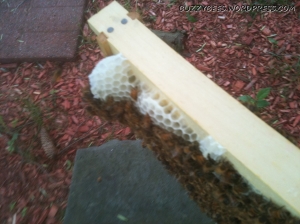
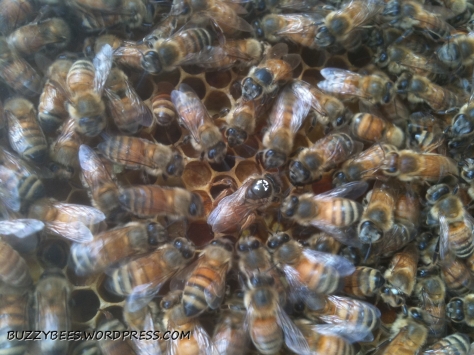
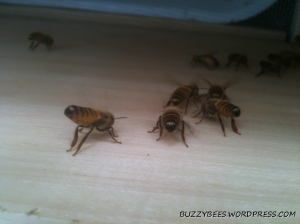
 After putting the brood chamber back together, I got a bit of relief when I inserted the new queen cage. When you install a new queen into an established colony, there is a possibility they may not initially accept her (she’s an intruder after all). To defend the colony, the bees will ‘ball’ up on the intruder similar to the picture at right. It’s somewhat savage, but the bees basically overpower the intruder and rip it to pieces. In the instance of a attacking hornet, like in the picture, this is a good thing. However, when the bees attempt to ball your new queen, you can tell that the old queen’s scent is still the one dominating the colony. Luckily, my bees did not pay the new queen any attention that was out of the ordinary. 🙂
After putting the brood chamber back together, I got a bit of relief when I inserted the new queen cage. When you install a new queen into an established colony, there is a possibility they may not initially accept her (she’s an intruder after all). To defend the colony, the bees will ‘ball’ up on the intruder similar to the picture at right. It’s somewhat savage, but the bees basically overpower the intruder and rip it to pieces. In the instance of a attacking hornet, like in the picture, this is a good thing. However, when the bees attempt to ball your new queen, you can tell that the old queen’s scent is still the one dominating the colony. Luckily, my bees did not pay the new queen any attention that was out of the ordinary. 🙂 The hunt for eggs & larva was a different story. I reinspected each frame, looking to see if I had missed any eggs/larva orsee if I could catch queen wandering around. This was also an opportunity to gauge how my capped brood was doing (i.e. was it increasing or decreasing) and to see if any supercedure or swarm cells developed. What I found was essentially the same as before – lots of honey and pollen, as well as a decreasing supply of capped brood and a number of empty brood cells. Uh Oh!
The hunt for eggs & larva was a different story. I reinspected each frame, looking to see if I had missed any eggs/larva orsee if I could catch queen wandering around. This was also an opportunity to gauge how my capped brood was doing (i.e. was it increasing or decreasing) and to see if any supercedure or swarm cells developed. What I found was essentially the same as before – lots of honey and pollen, as well as a decreasing supply of capped brood and a number of empty brood cells. Uh Oh!